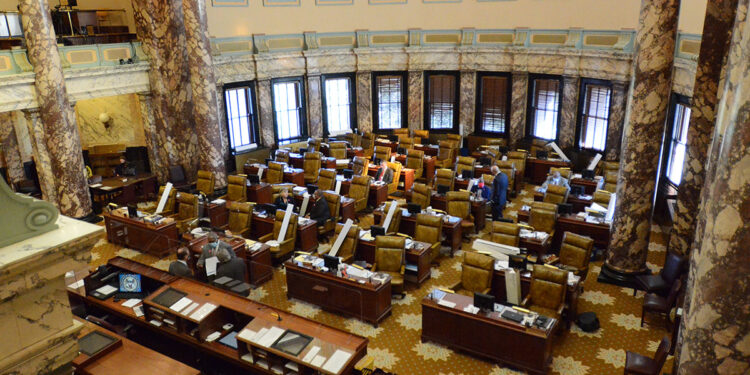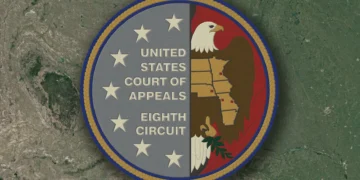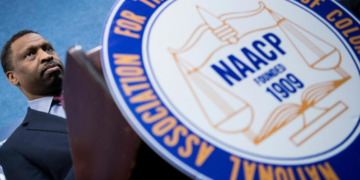April 1, 2025 Story by: Publisher
The Mississippi NAACP chapter and DeSoto County are making legal objections to the Mississippi Legislature’s redrawn legislative district maps in two separate court briefs, with both complaining that the plans for DeSoto County do not offer equal participation in the political process.
DeSoto County says the Mississippi Legislature’s newly redrawn legislative district maps “violate traditional redistricting principles and place DeSoto residents’ representative rights at risk.”
“… As will be discussed more fully, however, in DeSoto County in particular, the District 1 and District 11 Senate maps dismantle communities of interest, disregard natural geographical boundaries, and distort commonsense cartography,” DeSoto County wrote in a March 14 court brief.
The NAACP wrote that the redrawn maps for the Senate’s redistricting of DeSoto County and the House’s new plan for Chickasaw and Monroe counties do not allow Black voters to have a fair chance to elect candidates of their choice.
“Because the Legislative Plans do not create new districts where Black voters have a realistic opportunity to elect candidates of their choice despite racially polarized voting, there is no functional change from the unlawful 2022 Plans,” the NAACP said in its March 14 brief.
Joint Resolution 1 alters the district lines of Mississippi House districts 16, 22, 36, 39 and 41 to create at least one more Black-majority House district in compliance with the federal court’s orders. Joint Resolution 202 revises the composition of Mississippi Senate districts 1, 2, 10, 11, 19, 34, 41, 42, 44 and 45 to create at least two more Black-majority Senate districts to follow the court’s orders.
The Senate voted to approve its redistricting plan, J.R. 202, by a 33-16 vote on Feb. 26, and the House passed it by a 67-51 vote on March 5. The House passed its redistricting proposal, J.R. 1, by a 81-33 vote on Feb. 6, and the Senate approved it with a 30-12 vote on March 5.
The Mississippi State Conference of the NAACP filed a lawsuit in 2022 against Mississippi Board of Election Commissioners, Gov. Tate Reeves, Attorney General Lynn Fitch and Mississippi Secretary of State Michael Watson, claiming that the legislative voting maps “illegally dilute the voting strength of Black Mississippians.”
The U.S. District Court for the Southern District of Mississippi’s Northern Division agreed with the NAACP in a 2024 decision and ordered the Legislature to redraw its districting maps to create more Black-majority districts to give Black voters equal participation in the political process.
The court ruled that the Legislature needs to create more Black-majority Senate districts around DeSoto County in North Mississippi and the city of Hattiesburg in South Mississippi and more Black-majority House districts in Chickasaw and Monroe counties.
The Dilemma with DeSoto County
The Senate’s 2025 redistricting proposal changes five districts in the DeSoto County area and five districts in the Pine Bluffs area. Ten Senate districts would have to host special elections on Nov. 4 if the plan becomes law.
Sen. Dean Kirby, R-Pearl, who sponsored J.R. 202, said on the Senate floor on Feb. 26 that he had two goals for redistricting: first, “whatever the court said, that’s what we have to do,” and second, to “be as fair to everyone as I can possibly be and be as open as I can possibly be to everyone.”
Since the map redraws DeSoto County into new districts, Sen. Michael McLendon, R-Hernando, and Sen. Reginald Jackson, D-Marks, would have to face each other in the Nov. 4 special election if both senators choose to run to represent Senate District 1. Jackson currently represents Senate District 11, while McLendon serves District 1 under the 2022 Senate District map. The new Senate District 1 would have a voting-age population that is 52.4% Black.
ACLU-Mississippi Executive Director Jarvis Dortch said Hernando in DeSoto County had a wealthy white population that had fewer voting barriers compared to the Black majority in the poor, rural Delta that has fewer transportation options and other barriers to voting.
“Based on the numbers we have run, it looks like a white candidate would be the favorite to win in that district because it includes a very high income area in the city of Hernando,” Dortch said.
J.R. 202 assigned parts of Hernando West, Hernando Central and Hernando to Senate District 1; Senate District 2 has the other part of Hernando West, and District 19 has the other parts of Hernando Central and Hernando East.
Ahead of the Senate passing its redistricting plan, the Hernando Board of Aldermen passed a resolution in February that opposes any plan to split Hernando’s primary voting precincts— Hernando West, Hernando Central and Hernando East—into different districts.
“We would like to see those three precincts stay together, so that whoever the senator is in the future, they need to know the vast majority of Hernando needs to be spoken for. I don’t think that’s an unreasonable request to say, ‘Hey, keep Hernando whole,’” Hernando Alderman Ben Piper said in an episode of The Boardroom Podcast that premiered on Feb. 7.
Sen. McLendon proposed an amendment to the resolution that revises the Senate districts that include parts of DeSoto County. He said Hernando should not be in the majority-minority district that includes parts of the Delta. His amendment failed.
“We are taking two cultures and pairing them together,” he said on the Senate floor on Feb. 26.
Senate District 11, the “existing minority district” from the 2022 redrawn maps became Senate District 1 in the 2025 proposal, while the 2025 map for Senate District 11 is the “newly created majority district” that does not have an incumbent senator to represent it, Kirby said on Feb. 26.
Under the 2022 plan, Senate District 11 had all of Tunica and Quitman counties’ precincts along with parts of Coahoma, DeSoto and Tate counties’ precincts. The 2025 plan shows Senate District 11 encompassing 12 additional DeSoto County districts and nine additional Tunica County precincts while removing precincts from Tate, Coahoma and Quitman counties. Sen. Jackson currently represents Senate District 11 under the 2022 map.
Dortch said the Senate should have created a new Black-majority district instead of redrawing the existing Black-majority Senate District 11. He said the revised District 11 drawing is “questionable” as to whether Black voters could elect candidates of their choice. The newly redrawn district also pairs a white Republican incumbent, Sen. Michael McLendon of Hernando, with a Black Democratic incumbent, Sen. Reginald Jackson of Marks, against each other in the November special election.
“Instead of creating an additional district, it seems like they have watered down the existing Black-majority district to the point where it’s going to be questionable, and the district that they’ve created that they’re claiming is in compliance with the court order does not perform,” Dortch told the Mississippi Free Press on March 17. “And when we say it doesn’t perform that means that when you look back at previous elections going back 10 years, you’ll see in races where Black candidates faced off with white candidates, that in a majority of those races, the white candidate won in this district. So this district is not one where Black voters are going to have a strong say who’s elected to the state Senate.”
Under the Legislature’s 2022 Senate district map, Senate Districts 1 and 2 only had DeSoto County precincts. The 2025 proposed Senate District 1 map adds some of the precincts from Coahoma, Tate, and Tunica counties and all of the precincts for Quitman County with part of DeSoto County’s precincts. The 2025 plan for Senate District 2 only includes DeSoto County and adds 13 of its precincts to the district. Sen. David Parker, R-Olive Branch, currently represents Senate District 2.
“Here’s the general concern that our county has is that if you look at the map, it takes the heart of DeSoto County, our county seat, and it drops it into a district that goes down four counties into the Delta,” Rep. Dan Eubanks, R-Walls, said on the House floor on March 5. “Now, here’s the problem: The needs and the problems of DeSoto County are unique to DeSoto County, and the needs of the Delta and the problems of the Delta are unique to the Delta.”
After reviewing the House’s and Senate’s redistricting proposals, Dortch said the ACLU “ran numbers” to determine which candidates would have more favorable outcomes in the new districts. After reviewing the data, he said the newly redrawn districts for DeSoto County do not appear to comply with the federal court’s orders.
Specifically, he said the Mississippi chapter of the ACLU had concerns about the Legislature’s redrawn maps for Senate District 1, Senate District 11, House District 16 and House District 22.
Dortch noted that the Legislature should have held a hearing before releasing the newly drawn redistricting maps to consult with the NAACP, ACLU and the state’s attorneys so lawmakers could choose how to proceed with redistricting based on their feedback.
“It’s hard to consider what’s going into those maps when there’s not a public or transparent way of seeing that process,” he told the Mississippi Free Press on March 17.
The NAACP wrote in its March 14 court briefing that the Legislature drafted the plans “behind closed doors” and quickly brought the pieces of legislation onto the House and Senate floors for a vote the day after lawmakers introduced the resolutions in committee meetings.
“Unlike with the 2022 Enacted Plans, there were no public meetings to solicit input from affected communities. Nor did the Legislature hold any public hearings or otherwise publicly solicit input from community leaders or experts,” the NAACP wrote.
Rep. Robert Johnson, D-Natchez, asked Sanford if he shared the plans with local officials, like mayors, aldermen and supervisors, and community leaders of the affected districts.
“I did not seek out local officials or community leaders. I did meet with all five of the members of this body whose districts are affected who live in those districts. And if anyone from those districts had contacted me or written a letter to me or sent a proposed map to me, I certainly would’ve considered it,” Sanford told Johnson on the House floor on Feb. 6. He said he was confident the federal court would approve of the House’s redistricting plan.
When Sen. Michael McLendon introduced his amendment to J.R. 202 on the Senate floor on Feb. 26, he expressed frustration that he could not send his redistricting map to the same professionals who approved the map Kirby presented. McLendon and the other senators, including Kirby, also do not know which mapping professionals approved the redistricting plan. The Legislature’s attorneys at Butler-Snow send the Senate’s maps to “mapping experts,” but then cannot tell the Legislature who the professionals are, Kirby told the Mississippi Free Press on March 12.
McLendon argued that the Legislature and the public should know who is approving the maps because public funds are paying for the redrawn maps. He said he was skeptical of the group that approved the 2025 redistricting plan because they also approved the 2022 redistricting plan, which the federal court ruled did not give Black voters the equal opportunity to elect candidates of their choice.
“I have some real concerns over the same group vetting it last time that said, ‘Don’t worry about a thing, this is going to be good,’ that we voted 45-7, and I was one of the 45 votes,” McLendon told Kirby on the Senate floor on Feb. 26.
“Senator, I thought we had a good map the first time myself, but the judges didn’t, so. We have to comply with the court, that’s the number-one thing, and I’m sure they were trying to be just as fair as we were over here,” Kirby replied.
On March 12, the Mississippi State Republican Party Executive Committee joined the Mississippi Board of Election Commissioners, Gov. Tate Reeves, Attorney General Lynn Fitch and Mississippi Secretary of State Michael Watson as the defendants of the lawsuit.
The Mississippi Free Press called the GOP executive committee and the spokesperson told this reporter to contact the committee’s law firm, Wise Carter, for a statement. The Mississippi Free Press contacted attorneys at the firm but did not receive a response by press time.
Redrawn Districts for Mississippi Senate
Senate District 1 would include Coahoma County’s Clarksdale 2, Clarksdale 3, Clarksdale 4, Clarksdale 4 North, part of Clarksdale 5, Clarksdale Courthouse, Coahoma, Jonestown, Lyons and Sasse St. Fire Station precincts; pPart of DeSoto County’s Endora, Hernando Central, Hernando East, Hernando West, and Nesbit West precincts; all of Quitman County’s precincts; part of Tate County’s: Arkabutla, Coldwater, Evansville, Senatobia 3, Senatobia No. 1, Senatobia No. 2, Senatobia No. 4 and Taylor precincts; part of Tunica County’s New Sub, Prichard, Robinsonville, Superintendent of Education, Tunica, Two Mile Lake precincts; and all of Tate County’s West End Store and White Oak precincts.
Senate District 2 would include DeSoto County’s Colonial Hills, DeSoto Central, Mineral Wells, Nesbit East, and part of the county’s Elmore, Endora, Greenbrook North, Greenbrook South, Hernando West, Horn Lake East, Horn Lake High School, Horn Lake Intermediate School, Lake Cormorant, Nesbit West, Northwest Community College, Olive Branch West, Pleasant Hill North, Southaven North, Southaven West, Summershill and Walls precincts.
Senate District 10 would include Lafayette County’s Abbeville, Philadelphia and part of Oxford 2 precincts; Marshall County’s Barton, Bethlehem, Byhalia, Cayce, Chulahoma, Cornersville, Early Grove, Laws Hill, Marianna, Mt. Pleasant, part of North Holly Springs District 2, North Cayce, Potts Camp, Redbanks, Slayden, South Holly Springs, Victoria, Wall Hill, Warsaw, Waterford, Watson and West Holly Springs precincts; Tate County’s part of Arkabutla, part of Coldwater, part of Evansville, Independence, Looxahoma, Palestine, Poagville 4, Poagville 5, Sarah, part of Senatobia 3, part of Senatobia No. 1, part of Senatobia No. 2, part of Senatobia No. 4, Sherrod, Strayhorn 1, Strayhorn 2, part of Taylor, Thyatira, Tyro and Wyatte precincts; and Union County’s Blythe, Imgomar, Macedonia, Pinedale and West Union precincts.
Senate District 11 would include DeSoto County’s part of Elmore, part of Greenbrook North, part of Greenbrook South, Horn Lake Central, part of Horn Lake East, part of Horn Lake High School, part of Horn Lake Intermediate School, Horn Lake North, Horn Lake West, part of Lake Cormorant, part of Northwest Community College, part of Southaven North, Southaven South, part of Southaven West and part of Walls precincts; and Tunica County’s Banks/Hambrick, Mhoon Landing, part of New Sub, part of Prichard, part of Robinsonville, part of Superintendent of Education, part of Tunica, Tunica Auditorium and WIN Job Center precincts.
Senate District 19 would contain precincts in DeSoto County’s Alphaba Cockrum, Baker’s Chapel, Bridgetown, Cumberland, Fairhaven, Hack’s Cross, part of Hernando Central, part of Hernando East, Ingram’s Mill, Lewisburg, Lewisburg East, Love, Miller, Olive Branch East, Olive Branch North, Olive Branch South, part of Olive Branch West and part of Pleasant Hill North.
Senate District 34 would cover precincts in Covington County’s Collins, Dry Creek, Gilmer/Yawn, Mitchell, Mt. Olive, Okahay, Rock Hill, Station Creek and part of Williamsburg precincts; all of Jasper County; Jones County’s Currie, Erata, part of G.V. Harrison Multipurpose Building, Gitano, Hebron, Lt. Ellis Center, Magnolia Center, part of Mauldin Comm. Center, North Laurel, Oak Park School, Parkview Baptist Church, part of Powers Comm. Center, Sandhill, part of Shady Grove, part of Sharon, part of Soso and West Ellisville.
Senate District 41 would include precincts in Covington County’s Lone Star/Black Jack, Richmond, Sanford, Seminary/West Collins, South Collins, Strahan and Williamsburg; Lamar County’s Baxterville, part of Breland, Greenville, Lumberton, Midway, Oloh, Rocky Branch and Sumrall; all of Marion County; Walthall County’s Darbun, Dexter, District 3 Tylertown, District 4 Tylertown, East Tylertown, East Tylertown Sub A, Improve, Mesa, North Knoxo, Sartinville, South Kirklin, South Knoxo, Varnell, West Tylertown and West Tylertown Sub A.
Senate District 42 would have precincts in Forrest County’s Barrontown-Macedonia, East Petal, Leeville, Petal Masonic Lodge, Sunrise and West Petal; Greene County’s Jones, Piave and Wade; Jones County’s Antioch, Blackwell, Bruce, Calhoun, Centerville, County Barn, part of G.V. Harrison Multipurpose Building, Glade School, Johnson, Landrum Comm. Center, Matthews, part of Mauldin Comm. Center, Moselle, Myrick, Ovett, Pinegrove, Pleasant Ridge, part of Powers Comm. Center, Rainey, Rustin, Sandersville Civic Center, part Shady Grove, part of Sharon, Shelton, part of Soso, Tuckers and Union; and Wayne County’s Corinth.
Senate District 44 would include the precincts of Forrest County’s Brooklyn, Carnes, Dantzler, Dixie, Maxie, Mclaurin, Richburg, Thames School, Timberton and part of Westside; Lamar County: part of Arnold Line, Bellevue, part of Breland 451, Lake Serene, Mill Creek, Oak Grove, Okahola, Pine Grove, Purvis, Richburg, South Purvis, part of Wesley Manor and Yawn; and all of Perry County.
Senate District 45 would contain the following precincts: Forrest County’s Camp School, Court Street, Dixie Pine-Central, Eatonville, Eureka School, Glendale, Hardy Street, Hattiesburg Cultural Center, Highland Park, Lillie Burney School, North Heights, Pinecrest, Rawls Springs, Rowan School, Sheeplo, Sigler Center, Train Depot, West Hills and part of Westside; and Lamar County’s part of Arnold Line, part Breland, Lamar Park, N E Lamar, part of Wesley Manor and Westover Precincts.
Redrawn Districts for Mississippi House
House District 16 would include Chickasaw County’s North Okalona precinct; Lee County’s Brewer, Old Union, Palmetto, Pleasant Grove, Shannon, Tupelo 3, Tupelo 4 North, Tupelo 4 South, Tupelo 5, Verona and Veteran’s Park precincts; Monroe County’s Nettleton and Wren precincts; and Pontotoc County’s Beckham, Troy and Woodland precincts.
House District 22 would represent Chickasaw County’s Anchor, Buena Vista, East Okolona, Egypt, North Houlka, North Okolona, Northwest Houston, Pearsall, Pleasant Grove, South Houlka, Southeast Houston, Sparta, Van Vleet, West Okolona and Woodland precincts; Clay County’s Pine Bluff precinct; Monroe County’s Aberdeen 3, Amory 5, Central Grove, North Aberdeen, South Aberdeen, Willis and Wren precincts.
House District 36 would be made up of Clay County’s Cairo, Caradine, Cedar Bluff, Central West Point, East West Point, North West Point, Pheba, Siloam, South West Point, Tibbee, Union Star, Vinton and West West Point precincts; Lowndes County’s Air Base, Brandon, Townsend Park and University precincts; Monroe County’s Aberdeen 3, Athens, Becker, Darracott, Gibson, Lackey, North Aberdeen 4, Prairie, South Aberdeen 4 and Wren precincts; and Oktibbeha County’s Center Grove/North Adaton and Maben precincts.
House District 39 would include Lowndes County’s Air Base, Brandon, Caledonia, First Assembly and University precincts; Monroe County’s Aberdeen 3, Amory 1, Amory 2, Athens, Becker, Bigbee 1, Boyds, Hamilton and Lackey Precincts.
House District 41 would contain Lowndes County’s 15th Street Church, Air Base, Coleman, East Columbus Gym, First Assembly, Hunt, Immanuel, New Hope, Rural Hill, Southside Church, Townsend Park, Trinity and University precincts.


















Your writing is a true testament to your expertise and dedication to your craft. I’m continually impressed by the depth of your knowledge and the clarity of your explanations. Keep up the phenomenal work!